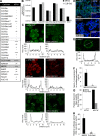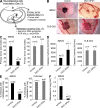Netrin-1 acts as a survival factor for aggressive neuroblastoma
- PMID: 19349462
- PMCID: PMC2715117
- DOI: 10.1084/jem.20082299
Netrin-1 acts as a survival factor for aggressive neuroblastoma
Abstract
Neuroblastoma (NB), the most frequent solid tumor of early childhood, is diagnosed as a disseminated disease in >60% of cases, and several lines of evidence support the resistance to apoptosis as a prerequisite for NB progression. We show that autocrine production of netrin-1, a multifunctional laminin-related molecule, conveys a selective advantage in tumor growth and dissemination in aggressive NB, as it blocks the proapoptotic activity of the UNC5H netrin-1 dependence receptors. We show that such netrin-1 up-regulation is a potential marker for poor prognosis in stage 4S and, more generally, in NB stage 4 diagnosed infants. Moreover, we propose that interference with the netrin-1 autocrine loop in malignant neuroblasts could represent an alternative therapeutic strategy, as disruption of this loop triggers in vitro NB cell death and inhibits NB metastasis in avian and mouse models.
Figures







References
-
- Mehlen P., Rabizadeh S., Snipas S.J., Assa-Munt N., Salvesen G.S., Bredesen D.E. 1998. The DCC gene product induces apoptosis by a mechanism requiring receptor proteolysis.Nature. 395:801–804 - PubMed
-
- Thibert C., Teillet M.A., Lapointe F., Mazelin L., Le Douarin N.M., Mehlen P. 2003. Inhibition of neuroepithelial patched-induced apoptosis by sonic hedgehog.Science. 301:843–846 - PubMed
-
- Matsunaga E., Tauszig-Delamasure S., Monnier P.P., Mueller B.K., Strittmatter S.M., Mehlen P., Chedotal A. 2004. RGM and its receptor neogenin regulate neuronal survival.Nat. Cell Biol. 6:749–755 - PubMed
Publication types
MeSH terms
Substances
LinkOut - more resources
Full Text Sources
Other Literature Sources
Medical
Research Materials

